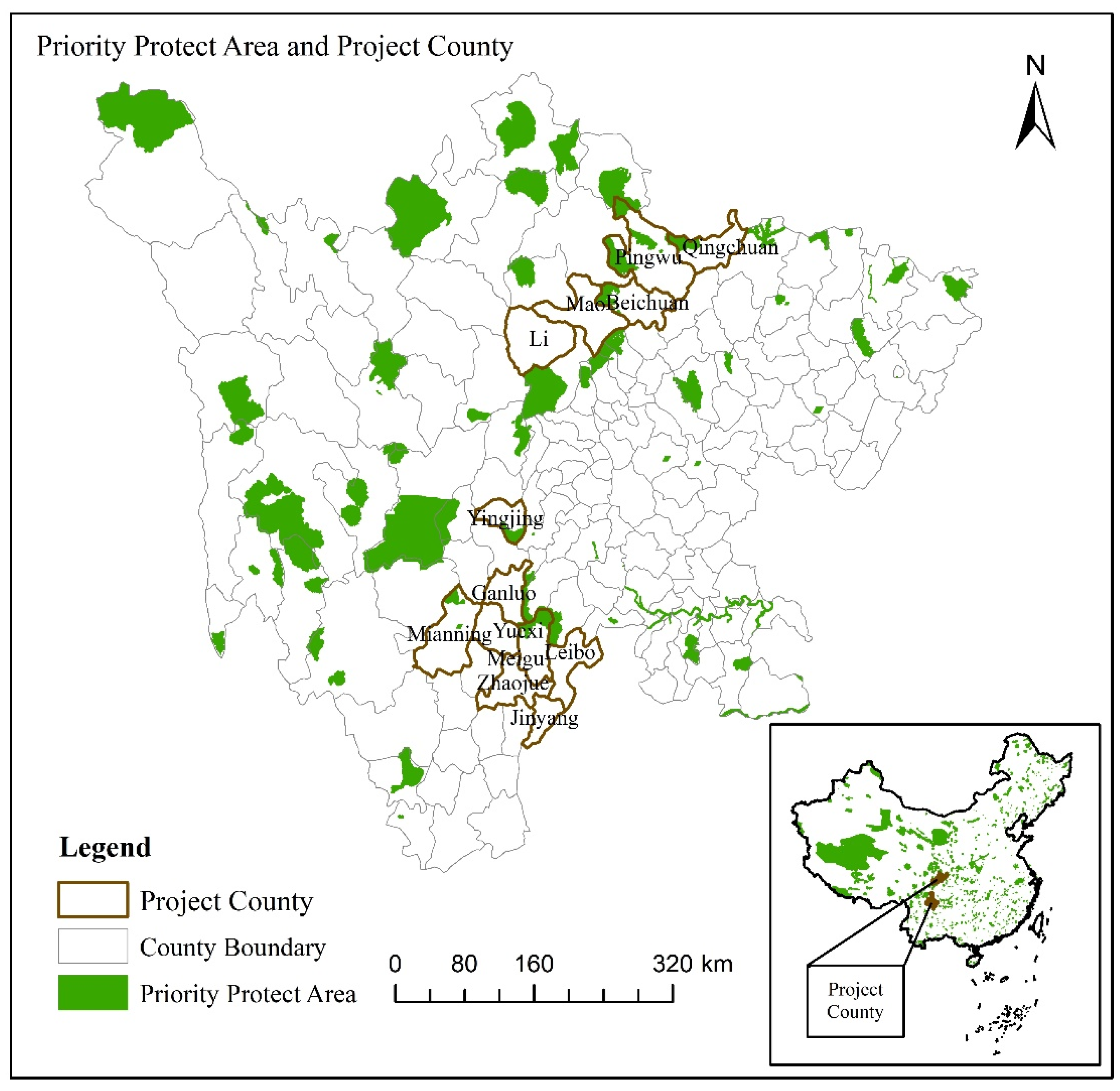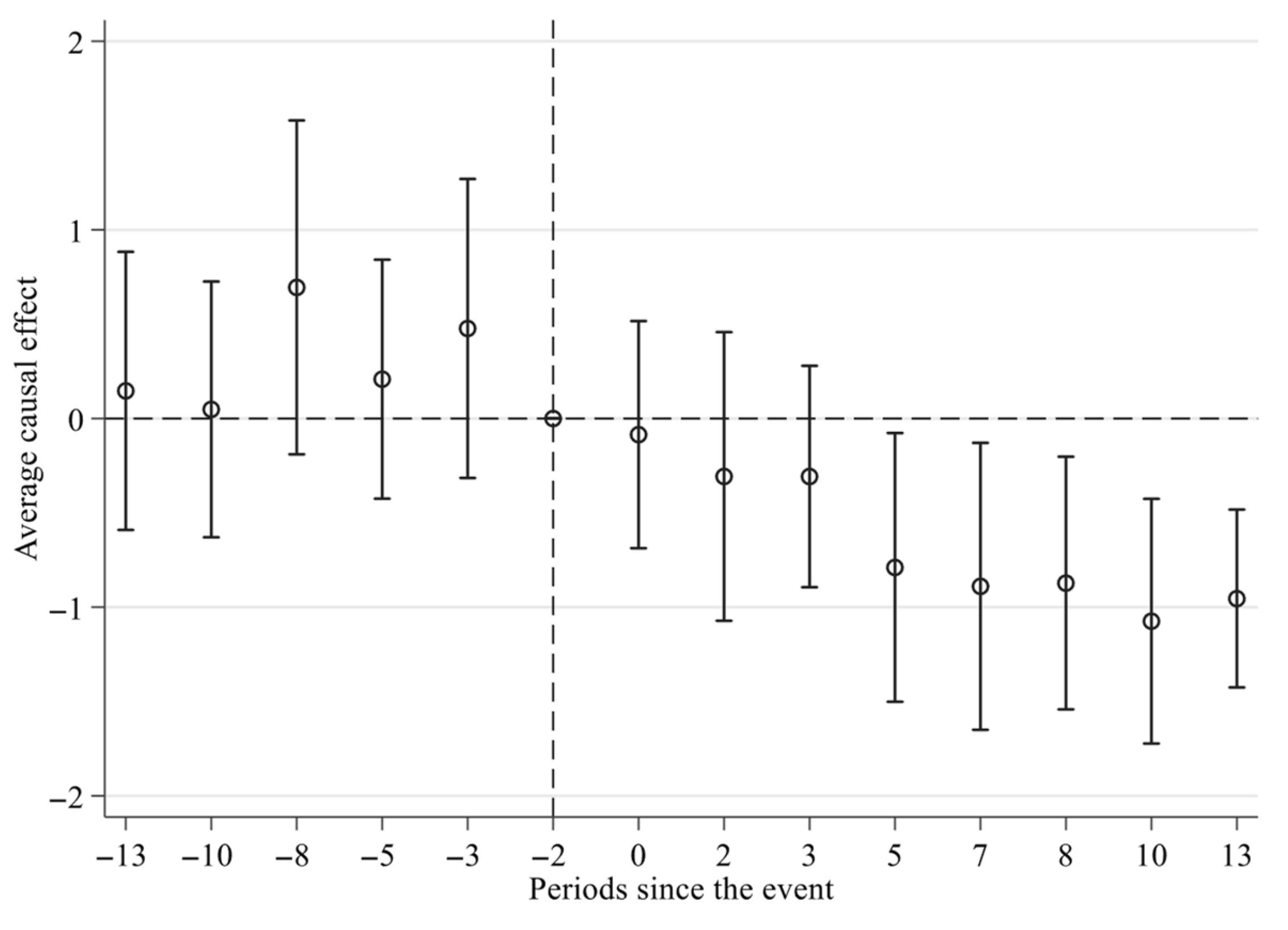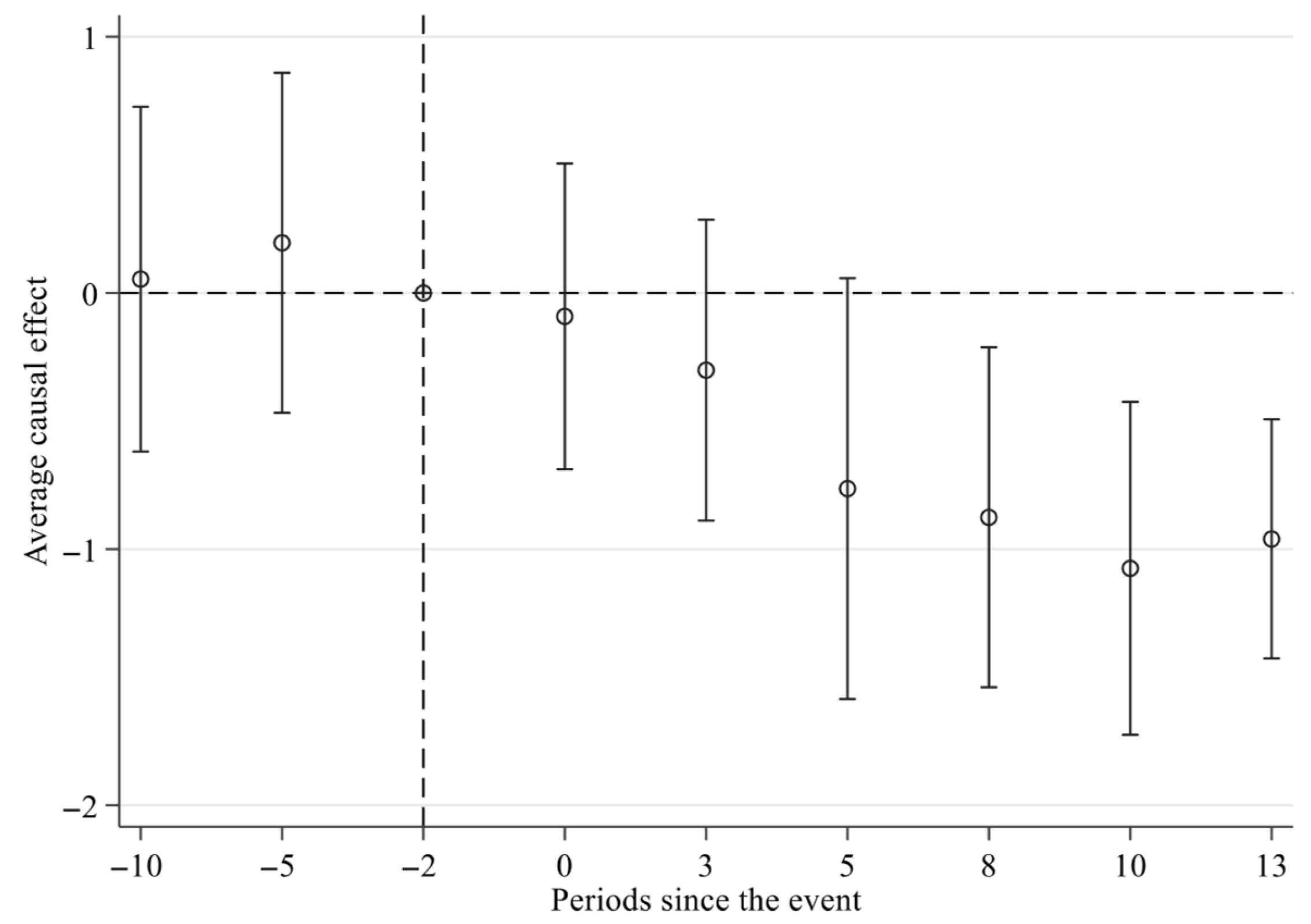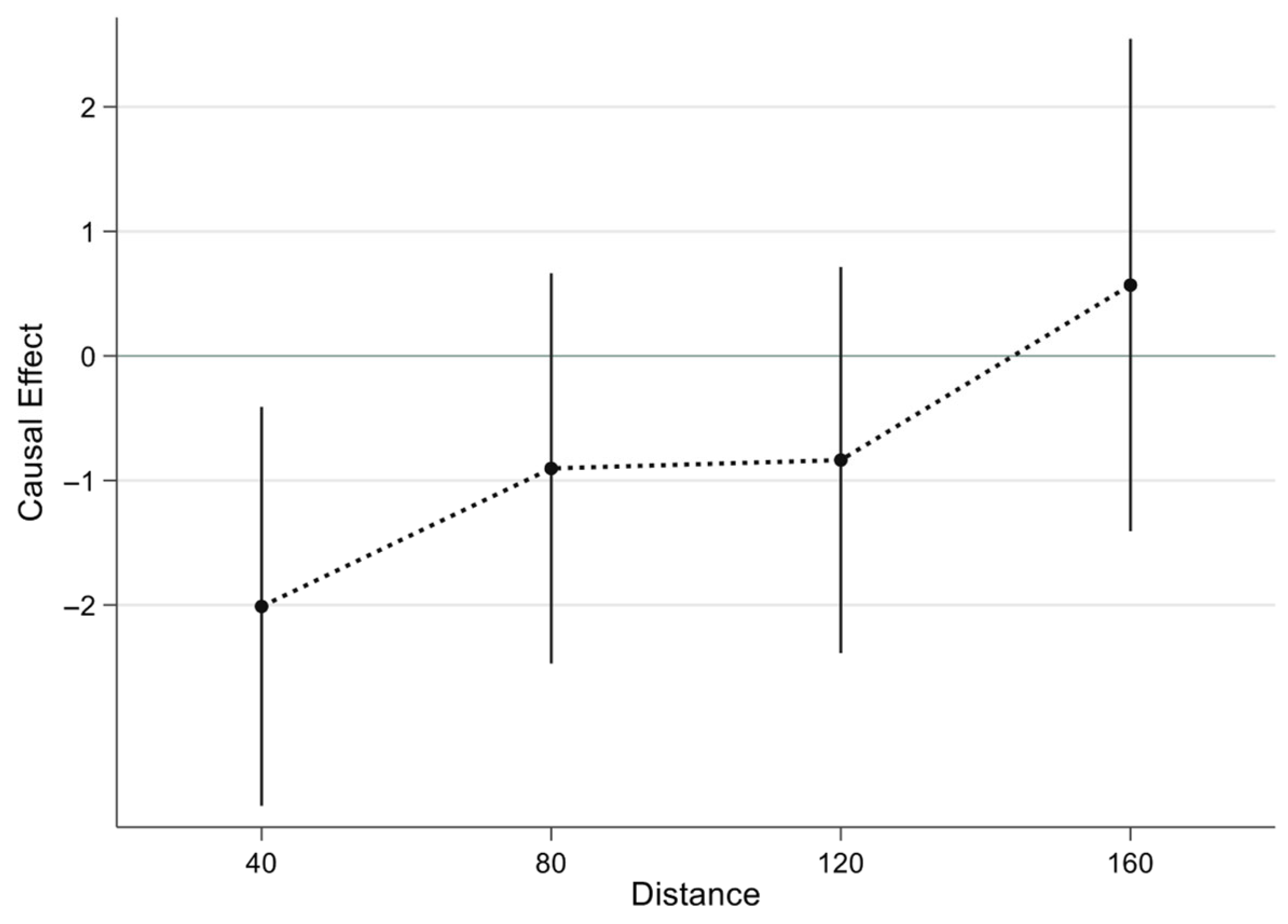Do Forest Carbon Offset Projects Bring Biodiversity Conservation Co-Benefits? An Examination Based on Ecosystem Service Value
Abstract
1. Introduction
2. Materials and Methods
2.1. Materials
2.1.1. Study Area
2.1.2. Data Source
2.2. Calculation Method of Forest Biodiversity Conservation Value
2.3. Staggered Difference in Differences Model
2.4. Event Study Model
2.5. Synthetic Difference-in-Differences Model
2.6. Spillover-Robust DID
2.7. Variable Descriptions
2.7.1. Dependent Variable
2.7.2. Independent Variable
2.7.3. Control Variables
3. Empirical Analysis
3.1. Baseline Regression Results
3.2. Analysis of Moderating Effects
3.3. Parallel Trend Tests and Estimation of Dynamic Treatment Effects
3.4. Forest Carbon Offset Projects with Biodiversity Conservation Certification
3.5. The Effects of Different Afforestation Approaches
3.6. Spatial Spillover Effect
3.7. Trade-Offs and Synergies Between Biodiversity Conservation and Carbon Benefits
4. Discussion
4.1. Comparison and Extension of Existing Studies
4.2. Policy Implications
4.3. Limitations of This Study
5. Conclusions
Supplementary Materials
Author Contributions
Funding
Data Availability Statement
Conflicts of Interest
References
- Arneth, A.; Shin, Y.-J.; Leadley, P.; Rondinini, C.; Bukvareva, E.; Kolb, M.; Midgley, G.F.; Oberdorff, T.; Palomo, I.; Saito, O. Post-2020 Biodiversity Targets Need to Embrace Climate Change. Proc. Natl. Acad. Sci. USA 2020, 117, 30882–30891. [Google Scholar] [CrossRef]
- Mooney, H.; Larigauderie, A.; Cesario, M.; Elmquist, T.; Hoegh-Guldberg, O.; Lavorel, S.; Mace, G.M.; Palmer, M.; Scholes, R.; Yahara, T. Biodiversity, Climate Change, and Ecosystem Services. Curr. Opin. Environ. Sustain. 2009, 1, 46–54. [Google Scholar] [CrossRef]
- Sintayehu, D.W. Impact of Climate Change on Biodiversity and Associated Key Ecosystem Services in Africa: A Systematic Review. Ecosyst. Health Sustain. 2018, 4, 225–239. [Google Scholar] [CrossRef]
- Mantyka-pringle, C.S.; Martin, T.G.; Rhodes, J.R. Interactions between Climate and Habitat Loss Effects on Biodiversity: A Systematic Review and Meta-Analysis. Glob. Change Biol. 2012, 18, 1239–1252. [Google Scholar] [CrossRef]
- Busch, J.; Godoy, F.; Turner, W.R.; Harvey, C.A. Biodiversity Co-Benefits of Reducing Emissions from Deforestation under Alternative Reference Levels and Levels of Finance. Conserv. Lett. 2011, 4, 101–115. [Google Scholar] [CrossRef]
- Díaz, S.; Hector, A.; Wardle, D.A. Biodiversity in Forest Carbon Sequestration Initiatives: Not Just a Side Benefit. Curr. Opin. Environ. Sustain. 2009, 1, 55–60. [Google Scholar] [CrossRef]
- Merger, E.; Dutschke, M.; Verchot, L. Options for REDD+ Voluntary Certification to Ensure Net GHG Benefits, Poverty Alleviation, Sustainable Management of Forests and Biodiversity Conservation. Forests 2011, 2, 550–577. [Google Scholar] [CrossRef]
- Alexander, S.; Nelson, C.R.; Aronson, J.; Lamb, D.; Cliquet, A.; Erwin, K.L.; Finlayson, C.M.; de Groot, R.S.; Harris, J.A.; Higgs, E.S.; et al. Opportunities and Challenges for Ecological Restoration within REDD+. Restor. Ecol. 2011, 19, 683–689. [Google Scholar] [CrossRef]
- Lee, D.-H.; Kim, D.; Kim, S. Characteristics of Forest Carbon Credit Transactions in the Voluntary Carbon Market. Clim. Policy 2018, 18, 235–245. [Google Scholar] [CrossRef]
- Grainger, A.; Boucher, D.H.; Frumhoff, P.C.; Laurance, W.F.; Lovejoy, T.; McNeely, J.; Niekisch, M.; Raven, P.; Sodhi, N.S.; Venter, O.; et al. Biodiversity and REDD at Copenhagen. Curr. Biol. 2009, 19, R974–R976. [Google Scholar] [CrossRef]
- Paoli, G.D.; Wells, P.L.; Meijaard, E.; Struebig, M.J.; Marshall, A.J.; Obidzinski, K.; Tan, A.; Rafiastanto, A.; Yaap, B.; Ferry Slik, J.; et al. Biodiversity Conservation in the REDD. Carbon Balance Manag. 2010, 5, 7. [Google Scholar] [CrossRef] [PubMed]
- He, J.; Wang, J. Certificated Exclusion: Forest Carbon Sequestration Project in Southwest China. J. Peasant Stud. 2023, 50, 2165–2186. [Google Scholar] [CrossRef]
- Ma, M.; Haapanen, T.; Singh, R.B.; Hietala, R. Integrating Ecological Restoration into CDM Forestry Projects. Environ. Sci. Policy 2014, 38, 143–153. [Google Scholar] [CrossRef][Green Version]
- Essl, F.; Erb, K.; Glatzel, S.; Pauchard, A. Climate Change, Carbon Market Instruments, and Biodiversity: Focusing on Synergies and Avoiding Pitfalls. WIREs Clim. Change 2018, 9, e486. [Google Scholar] [CrossRef]
- Veldman, J.W.; Overbeck, G.E.; Negreiros, D.; Mahy, G.; Le Stradic, S.; Fernandes, G.W.; Durigan, G.; Buisson, E.; Putz, F.E.; Bond, W.J. Where Tree Planting and Forest Expansion Are Bad for Biodiversity and Ecosystem Services. BioScience 2015, 65, 1011–1018. [Google Scholar] [CrossRef]
- Sabatini, F.M.; de Andrade, R.B.; Paillet, Y.; Ódor, P.; Bouget, C.; Campagnaro, T.; Gosselin, F.; Janssen, P.; Mattioli, W.; Nascimbene, J.; et al. Trade-Offs between Carbon Stocks and Biodiversity in European Temperate Forests. Glob. Change Biol. 2019, 25, 536–548. [Google Scholar] [CrossRef]
- Tinya, F.; Doerfler, I.; de Groot, M.; Heilman-Clausen, J.; Kovács, B.; Mårell, A.; Nordén, B.; Aszalós, R.; Bässler, C.; Brazaitis, G.; et al. A Synthesis of Multi-Taxa Management Experiments to Guide Forest Biodiversity Conservation in Europe. Glob. Ecol. Conserv. 2023, 46, e02553. [Google Scholar] [CrossRef]
- Mace, G.M.; Norris, K.; Fitter, A.H. Biodiversity and Ecosystem Services: A Multilayered Relationship. Trends Ecol. Evol. 2012, 27, 19–26. [Google Scholar] [CrossRef]
- Costanza, R.; d’Arge, R.; de Groot, R.; Farber, S.; Grasso, M.; Hannon, B.; Limburg, K.; Naeem, S.; O’Neill, R.V.; Paruelo, J.; et al. The Value of the World’s Ecosystem Services and Natural Capital. Nature 1997, 387, 253–260. [Google Scholar] [CrossRef]
- Tongqian, Z.; Zhiyun, O.; Liangqing, J.; Hua, Z. Ecosystem Services and Their Valuation of China Grassland. Acta Ecol. Sin. 2004, 24, 1101–1110. [Google Scholar]
- Costanza, R.; de Groot, R.; Sutton, P.; van der Ploeg, S.; Anderson, S.J.; Kubiszewski, I.; Farber, S.; Turner, R.K. Changes in the Global Value of Ecosystem Services. Glob. Environ. Change 2014, 26, 152–158. [Google Scholar] [CrossRef]
- Xie, G.; Zhen, L.; LU, C.; Xiao, Y.; Chen, C. Expert Knowledge Based Valuation Method of Ecosystem Services in China. J. Nat. Resour. 2008, 23, 911–919. [Google Scholar] [CrossRef]
- Xie, G.; Lu, C.-X.; Leng, Y.-F.; Zheng, D.; Li, S. Ecological Assets Valuation of the Tibetan Plateau. J. Nat. Resour. 2003, 18, 189–196. [Google Scholar] [CrossRef]
- Xie, H.; He, Y.; Xie, X. Exploring the Factors Influencing Ecological Land Change for China’s Beijing–Tianjin–Hebei Region Using Big Data. J. Clean. Prod. 2017, 142, 677–687. [Google Scholar] [CrossRef]
- Panfil, S.N.; Harvey, C.A. REDD+ and Biodiversity Conservation: A Review of the Biodiversity Goals, Monitoring Methods, and Impacts of 80 REDD+ Projects: Biodiversity Conservation in REDD+ Projects. Conserv. Lett. 2016, 9, 143–150. [Google Scholar] [CrossRef]
- Arkhangelsky, D.; Athey, S.; Hirshberg, D.A.; Imbens, G.W.; Wager, S. Synthetic Difference-in-Differences. Am. Econ. Rev. 2021, 111, 4088–4118. [Google Scholar] [CrossRef]
- Callaway, B.; Sant’Anna, P.H.C. Difference-in-Differences with Multiple Time Periods. J. Econom. 2021, 225, 200–230. [Google Scholar] [CrossRef]
- Magnago, L.F.S.; Magrach, A.; Laurance, W.F.; Martins, S.V.; Meira-Neto, J.A.A.; Simonelli, M.; Edwards, D.P. Would Protecting Tropical Forest Fragments Provide Carbon and Biodiversity Cobenefits under REDD+? Glob. Change Biol. 2015, 21, 3455–3468. [Google Scholar] [CrossRef]
- Phelps, J.; Webb, E.L.; Adams, W.M. Biodiversity Co-Benefits of Policies to Reduce Forest-Carbon Emissions. Nat. Clim. Change 2012, 2, 497–503. [Google Scholar] [CrossRef]
- Palomo, I.; Dujardin, Y.; Midler, E.; Robin, M.; Sanz, M.J.; Pascual, U. Modeling Trade-Offs across Carbon Sequestration, Biodiversity Conservation, and Equity in the Distribution of Global REDD+ Funds. Proc. Natl. Acad. Sci. USA 2019, 116, 22645–22650. [Google Scholar] [CrossRef]
- Sarira, T.V.; Zeng, Y.; Neugarten, R.; Chaplin-Kramer, R.; Koh, L.P. Co-Benefits of Forest Carbon Projects in Southeast Asia. Nat. Sustain. 2022, 5, 393–396. [Google Scholar] [CrossRef]
- Ng, C.N.; Xie, Y.J.; Yu, X.J. Integrating Landscape Connectivity into the Evaluation of Ecosystem Services for Biodiversity Conservation and Its Implications for Landscape Planning. Appl. Geogr. 2013, 42, 1–12. [Google Scholar] [CrossRef]
- Beck, T.; Levine, R.; Levkov, A. Big Bad Banks? The Winners and Losers from Bank Deregulation in the United States. J. Financ. 2010, 65, 1637–1667. [Google Scholar] [CrossRef]
- Greenaway-McGrevy, R.; Phillips, P.C.B. The Impact of Upzoning on Housing Construction in Auckland. J. Urban Econ. 2023, 136, 103555. [Google Scholar] [CrossRef]
- Costanza, R.; Fisher, B.; Mulder, K.; Liu, S.; Christopher, T. Biodiversity and Ecosystem Services: A Multi-Scale Empirical Study of the Relationship between Species Richness and Net Primary Production. Ecol. Econ. 2007, 61, 478–491. [Google Scholar] [CrossRef]
- Liu, J.; Coomes, D.A.; Gibson, L.; Hu, G.; Liu, J.; Luo, Y.; Wu, C.; Yu, M. Forest Fragmentation in China and Its Effect on Biodiversity. Biol. Rev. 2019, 94, 1636–1657. [Google Scholar] [CrossRef] [PubMed]
- Roshni, N.A.; Hasan, M.K.; Akter, R.; Prodhan, A.K.M.A.-U.-D.; Sagar, A. Impacts of Industrialization on Plant Species Composition, Diversity, and Tree Population Structure in Tropical Moist Deciduous Forest in Bangladesh. Int. J. For. Res. 2022, 2022, 3959617. [Google Scholar] [CrossRef]
- Brockerhoff, E.G.; Jactel, H.; Parrotta, J.A.; Quine, C.P.; Sayer, J. Plantation Forests and Biodiversity: Oxymoron or Opportunity? Biodivers. Conserv. 2008, 17, 925–951. [Google Scholar] [CrossRef]
- Osawa, T.; Kohyama, K.; Mitsuhashi, H. Trade-off Relationship between Modern Agriculture and Biodiversity: Heavy Consolidation Work Has a Long-Term Negative Impact on Plant Species Diversity. Land Use Policy 2016, 54, 78–84. [Google Scholar] [CrossRef]
- Bianchi, F.J.J.A.; Mikos, V.; Brussaard, L.; Delbaere, B.; Pulleman, M.M. Opportunities and Limitations for Functional Agrobiodiversity in the European Context. Environ. Sci. Policy 2013, 27, 223–231. [Google Scholar] [CrossRef]
- Luck, G.W. A Review of the Relationships between Human Population Density and Biodiversity. Biol. Rev. 2007, 82, 607–645. [Google Scholar] [CrossRef]
- Liu, X.; Trogisch, S.; He, J.-S.; Niklaus, P.A.; Bruelheide, H.; Tang, Z.; Erfmeier, A.; Scherer-Lorenzen, M.; Pietsch, K.A.; Yang, B.; et al. Tree Species Richness Increases Ecosystem Carbon Storage in Subtropical Forests. Proc. R. Soc. B Biol. Sci. 2018, 285, 20181240. [Google Scholar] [CrossRef]
- Pawson, S.M.; Brin, A.; Brockerhoff, E.G.; Lamb, D.; Payn, T.W.; Paquette, A.; Parrotta, J.A. Plantation Forests, Climate Change and Biodiversity. Biodivers. Conserv. 2013, 22, 1203–1227. [Google Scholar] [CrossRef]
- Wang, X.; Hua, F.; Wang, L.; Wilcove, D.S.; Yu, D.W. The Biodiversity Benefit of Native Forests and Mixed-Species Plantations over Monoculture Plantations. Divers. Distrib. 2019, 25, 1721–1735. [Google Scholar] [CrossRef]
- Galik, C.S.; Baker, J.S.; Daigneault, A.; Latta, G. Crediting Temporary Forest Carbon: Retrospective and Empirical Perspectives on Accounting Options. Front. For. Glob. Change 2022, 5, 933020. [Google Scholar] [CrossRef]
- Cagnoni, L.B.; Weidlich, E.W.A.; Guillemot, J.; Morselo, C.; Weih, M.; Adler, A.; Brancalion, P.H.S. Stakeholders’ Perspectives of Species Diversity in Tree Plantations: A Global Review. Curr. For. Rep. 2023, 9, 251–262. [Google Scholar] [CrossRef]
- Lin, D.; Lin, Y. Stakeholders of Voluntary Forest Carbon Offset Projects in China: An Empirical Analysis. Adv. Meteorol. 2015, 2015, 518698. [Google Scholar] [CrossRef]
- Chia, E.L.; Fobissie, K.; Kanninen, M. Exploring Opportunities for Promoting Synergies between Climate Change Adaptation and Mitigation in Forest Carbon Initiatives. Forests 2016, 7, 24. [Google Scholar] [CrossRef]
- Liu, S.; Zhang, H.; Xie, F.; Guo, S. Current Situation and Influencing Factors of Pluriactivity in Mountainous and Hilly Rural Areas of Sichuan Province, China. J. Mt. Sci. 2013, 10, 445–454. [Google Scholar] [CrossRef]
- Xu, D.; Cao, S.; Wang, X.; Liu, S. Influences of Labor Migration on Rural Household Land Transfer: A Case Study of Sichuan Province, China. J. Mt. Sci. 2018, 15, 2055–2067. [Google Scholar] [CrossRef]
- La Ferrara, E.; Chong, A.; Duryea, S. Soap Operas and Fertility: Evidence from Brazil. Am. Econ. J. Appl. Econ. 2012, 4, 1–31. [Google Scholar] [CrossRef]
- De Chaisemartin, C.; d’Haultfoeuille, X. Two-Way Fixed Effects Estimators with Heterogeneous Treatment Effects. Am. Econ. Rev. 2020, 110, 2964–2996. [Google Scholar] [CrossRef]
- Li, B.; Gasser, T.; Ciais, P.; Piao, S.; Tao, S.; Balkanski, Y.; Hauglustaine, D.; Boisier, J.-P.; Chen, Z.; Huang, M.; et al. The Contribution of China’s Emissions to Global Climate Forcing. Nature 2016, 531, 357–361. [Google Scholar] [CrossRef]




| Project Name | County | Project Type | CCB | Start Year | Accounting Period (Years) | Coverage Area (ha) |
|---|---|---|---|---|---|---|
| China Northwestern Sichuan Degraded Land Afforestation and Reforestation Project | Li | CDM | Yes | 2004 | 20 | 747.8 |
| Mao | CDM | Yes | 2004 | 20 | 234.9 | |
| Beichuan | CDM | Yes | 2004 | 20 | 200.2 | |
| Qingchuan | CDM | Yes | 2004 | 20 | 878.3 | |
| Pingwu | CDM | Yes | 2004 | 20 | 190.6 | |
| Novartis Southwestern Sichuan Degraded Land Afforestation and Reforestation Project | Ganluo | CDM | Yes | 2010 | 30 | 924.3 |
| Yuexi | CDM | Yes | 2010 | 30 | 1245 | |
| Meigu | CDM | Yes | 2010 | 30 | 731.6 | |
| Zhaojue | CDM | Yes | 2010 | 30 | 441.8 | |
| Leibo | CDM | Yes | 2010 | 30 | 854.1 | |
| Sichuan Province Yingjing County Reforestation Project | Yingjing | VCS | No | 2011 | 30 | 159.2 |
| Audi Panda Habitat Multi-Benefit Forest Restoration and Carbon Offset Project | Mianning | CCER | No | 2012 | 30 | 153.4 |
| Jinyang | CCER | No | 2012 | 30 | 181.7 |
| Variable | Definition | Obs. | Mean | Sdv. | Min | Max | |
|---|---|---|---|---|---|---|---|
| Dependent Variable | lnbio_esv | Biodiversity Conservation Value (Million CNY) (ln) | 1024 | 6.028 | 3.331 | 0.002 | 13.952 |
| Independent Variable | FCOP | Whether the county is implementing a forest carbon offset project | 1024 | 0.070 | 0.256 | 0 | 1 |
| Control Variables | forest | Forest Area Coverage (%) | 1024 | 41.039 | 26.151 | 0.014 | 91.884 |
| temperature | Annual Average Temperature (°C) | 1024 | 16.262 | 3.953 | 2.214 | 21.636 | |
| rainfall | Rainfall (mm) | 1024 | 1041.709 | 247.431 | 480.226 | 2158.709 | |
| second_ind | Total Industrial Output Above Designated Size/Regional GDP | 1024 | 0.389 | 0.157 | 0.042 | 0.797 | |
| agriculture_output | Agricultural Output/Regional GDP | 1024 | 0.369 | 0.207 | 0.047 | 0.869 | |
| agriculturepower | Total Agricultural Machinery Power (Kilowatt) (ln) | 1024 | 2.628 | 0.918 | 0.693 | 4.605 | |
| population | Registered Population/Administrative Land Area (Square Kilometers) | 1024 | 0.026 | 0.025 | 0.001 | 0.109 | |
| Moderating Variables | agricultural land pressure | Cultivated Land Area per Permanent Resident | 1024 | 13.892 | 7.329 | 0.003 | 37.546 |
| livestock intensity | Large Livestock Slaughter Number (ln) | 1010 | 11.072 | 1.090 | 6.639 | 13.819 |
| Variables | Dependent Variable: lnbio_esv | |
|---|---|---|
| (1) | (2) | |
| FCOP | −0.924 *** | −0.801 *** |
| (0.236) | (0.230) | |
| Constant | 6.093 *** | 9.699 *** |
| (0.017) | (2.172) | |
| Control Variables | NO | YES |
| County FE | YES | YES |
| Year FE | YES | YES |
| Observations | 1024 | 1024 |
| R-squared | 0.855 | 0.865 |
| Variables | Dependent Variable: lnbio_esv | |
|---|---|---|
| (1) | (2) | |
| FCOP X Livestock Intensity | −0.378 * | |
| (0.220) | ||
| FCOP X Agricultural Land Pressure | 0.082 * | |
| (0.046) | ||
| FCOP | −0.645 *** | −1.387 *** |
| (0.240) | (0.409) | |
| Constant | 9.029 *** | 11.908 *** |
| (2.563) | (3.242) | |
| Control Variables | YES | YES |
| County FE | YES | YES |
| Year FE | YES | YES |
| Observations | 1010 | 1024 |
| R-squared | 0.864 | 0.867 |
| Variables | Dependent Variable: lnbio_esv | |
|---|---|---|
| (1) | (2) | |
| FCOP | −0.854 *** | −0.760 *** |
| (0.312) | (0.288) | |
| Constant | 6.079 *** | 9.743 *** |
| (0.019) | (2.252) | |
| Control Variables | NO | YES |
| County FE | YES | YES |
| Year FE | YES | YES |
| Observations | 1000 | 1000 |
| R-squared | 0.853 | 0.864 |
| Variables | (1) Monocultures | (2) Native Species |
|---|---|---|
| esv_bio | esv_bio | |
| FCOP | −0.990 *** | 0.533 ** |
| (0.242) | (0.258) | |
| Constant | 9.781 *** | 9.491 *** |
| (2.186) | (2.338) | |
| Control Variables | YES | YES |
| County FE | YES | YES |
| Year FE | YES | YES |
| Observations | 1000 | 944 |
| R-squared | 0.865 | 0.862 |
| Variables | CCB | NON-CCB | ||
|---|---|---|---|---|
| (1) | (2) | (3) | (4) | |
| lncarbonstock | lnbio_esv | lncarbonstock | lnbio_esv | |
| FCOP | 0.181 *** | −0.760 *** | 0.025 | −0.806 *** |
| (0.043) | (0.288) | (0.031) | (0.292) | |
| Constant | 0.635 *** | 9.743 *** | 0.582 *** | 9.265 *** |
| (0.114) | (2.252) | (0.105) | (2.252) | |
| Control Variables | YES | YES | YES | YES |
| County FE | YES | YES | YES | YES |
| Year FE | YES | YES | YES | YES |
| Observations | 875 | 1000 | 833 | 952 |
| R-squared | 0.995 | 0.864 | 0.996 | 0.865 |
Disclaimer/Publisher’s Note: The statements, opinions and data contained in all publications are solely those of the individual author(s) and contributor(s) and not of MDPI and/or the editor(s). MDPI and/or the editor(s) disclaim responsibility for any injury to people or property resulting from any ideas, methods, instructions or products referred to in the content. |
© 2025 by the authors. Licensee MDPI, Basel, Switzerland. This article is an open access article distributed under the terms and conditions of the Creative Commons Attribution (CC BY) license (https://creativecommons.org/licenses/by/4.0/).
Share and Cite
Wang, Q.; Hu, Y.; Chen, R.; Zeng, W.; Cheng, Y. Do Forest Carbon Offset Projects Bring Biodiversity Conservation Co-Benefits? An Examination Based on Ecosystem Service Value. Forests 2025, 16, 1274. https://doi.org/10.3390/f16081274
Wang Q, Hu Y, Chen R, Zeng W, Cheng Y. Do Forest Carbon Offset Projects Bring Biodiversity Conservation Co-Benefits? An Examination Based on Ecosystem Service Value. Forests. 2025; 16(8):1274. https://doi.org/10.3390/f16081274
Chicago/Turabian StyleWang, Qi, Yuan Hu, Rui Chen, Weizhong Zeng, and Ying Cheng. 2025. "Do Forest Carbon Offset Projects Bring Biodiversity Conservation Co-Benefits? An Examination Based on Ecosystem Service Value" Forests 16, no. 8: 1274. https://doi.org/10.3390/f16081274
APA StyleWang, Q., Hu, Y., Chen, R., Zeng, W., & Cheng, Y. (2025). Do Forest Carbon Offset Projects Bring Biodiversity Conservation Co-Benefits? An Examination Based on Ecosystem Service Value. Forests, 16(8), 1274. https://doi.org/10.3390/f16081274






